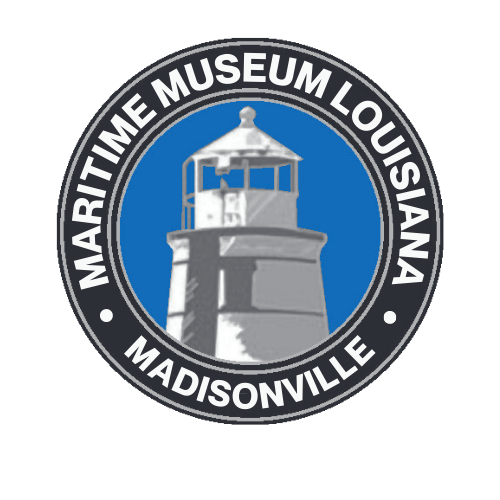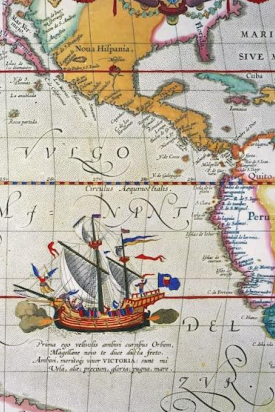Early Explorers of the Gulf, the Basin, and the Mississippi River - Part A
This brief starts a bit far-a-field but attempts to provide a chronological context for the exploration of the “new world” during the period designated as the Age of Discovery. An effort has been made to identify the principal explorers during this period but should not be considered as comprehensive. This and its companion brief that follows next month will provide greater detail concerning those explorers whose principal focus was that of the Gulf of Mexico, its bordering lands, and the Mississippi River.
Indigenous people lived, fished, and hunted along the banks of the Mississippi River and its tributaries, the shores of the Gulf of Mexico and Lake Pontchartrain and its tributaries for thousands of years in advance of the early explorers to those areas. Unfortunately, these people did not have a written language, therefore their history is largely written by explorers who came in contact with them and by archaeologists and historians who studied and interpreted the artifacts they left behind. Recently reported research indicates that the two mounds on the Louisiana State University campus were built thousands of years ago. Carbon dating of the samples taken from one of the mounds established that building of the mound started more than 11,000 years ago! Contrast that with the fact that the British fort in the Baton Rouge area, Fort New Richmond, was built in 1765. Noteworthy is the fact that the LSU mounds are only two of the more than 800 mounds located in Louisiana. This suggests a very intensive and widespread community of indigenous people. It should be noted that in many instances the indigenous people served as guides to early explorers and in some circumstances provided them with food and shelter. Savvy explorers shared practical and ornamental items with the indigenous people to foster good relations and fair trade. For example, various tribes of indigenous people were particularly helpful in guiding and helping the explorations of d’Iberville and d’Bienville in the late 1600’s and early 1700’s. Hostilities did erupt from time to time between the indigenous people and the early explorers. Unfortunately, the explorers exposed the indigenous people to diseases for which they had no treatment or natural immunity.
Before reviewing in-depth the efforts and discoveries of the early explorers of the Mississippi River, the Gulf of Mexico, and the Basin, let’s review a chronological listing of some of the important early explorers to the “new world” and a capsulated summary of their objectives and findings. This listing, while not comprehensive, will provide some historical context to the timeframe for exploration in the Gulf compared to other geographical areas of North and South America and the Pacific Ocean.
c1000- Leif Eriksson sails to what is now the coast of Canada (possibly Baffin Island) based on the stories of Icelandic trader Bjarni Herjolfsson. Herjolfsson is reported to have overshot Greenland on one of his voyages over a decade earlier and sailed to and along the shores of North America without having gone ashore. Eriksson and his crew ventured further south, ultimately establishing a base camp on the north tip of the island of Newfoundland- a region Eriksson named Vinland. After remaining in Vinland through the winter season, Eriksson returned to Greenland but never returned to Vinland. Other Vikings sailed to Vinland over the next decade but failed to establish a permanent settlement, possibly due to hostilities with the indigenous people in the area.
While not specific to Eriksson, researchers recently published a paper in the University of Iceland journal Antiquity that reports that Vikings travelled to the Americas some 500 years before Columbus. Their findings were based on the discovery of tree species in Greenland native to Canada but not to Greenland. The researchers further concluded that Vikings were making regular visits to the Americas to restock their tree farms. The imported timber species, specifically hemlock and jack pine, were being used for ship building and large construction projects. After a lapse of almost 500 years, a period starting in the late 15th Century and extending into the early 18th Century is characterized by the initiation and proliferation of exploratory voyages, first by Spanish and Portuguese explorers and subsequently followed by English, French and Dutch explorers, to the “new world.” This period is known as the Age of Discovery, also known as the Age of Exploration. The initiation of this period was significantly aided by the development of vessels primarily dependent on sail power as contrasted by limited human power applied through oars. The period more or less overlapped with the Age of Sail. European exploration outside of the Mediterranean Sea began as early as 1336 with a Portuguese expedition to the Canary Islands and later with discoveries of the Atlantic archipelagos of Madeira and the Azores. As generally understood, colonization of the Americas began with the voyages of Christopher Columbus under the Spanish flag.
1492- Columbus launched his first expedition to discover a ‘northwest passage” to East Asia in order to establish a shorter trade route to China. Supported by Queen Isabella I of Castille, this voyage led to the discovery of the Bahamas, Cuba, and Hispaniola.
1494-1502- Columbus makes three more voyages seeking the “northwest passage” and discovers Jamaica, Puerto Rico, Trinidad, and the Virgin Islands.
1497- Giovanni Caboto (aka John Cabot), albeit an Italian navigator and explorer, gained the support of English King Henry VII for an expedition to the New World. He is actually credited with making two expeditions out of Bristol, England, to the North American coast in 1497 for which little is known about the first. These expeditions are judged to be the earliest known European expeditions of coastal North America since the expeditions of Eriksson in the 11 th Century. Some evidence exists that suggests that Caboto explored the coast of Newfoundland and, possibly, Cape Breton Island. It is believed that he only went ashore briefly on one occasion. Caboto made yet a third voyage across the Atlantic beginning in May 1498 for which there are alternate accounts of the outcomes ranging from his fleet being lost at sea or that it completed an extensive exploration of the North American coast as far south as the Chesapeake Bay area and possibly the Spanish territories in the Caribbean and successfully returned to England in 1500.
1497- Amerigo Vespucci has been cited by some sources as the first to explore the Gulf of Mexico. However, the purported report of this voyage has been widely disputed with the result that many historians doubt that the voyage actually took place as reported.
1497- Vasco da Gama (shown below) was a Portuguese explorer and the first to reach India by sea by way of the Cape of Good Hope.This was the first voyage to link Europe and Asia with an ocean route. This voyage is considered to be a milestone in world history because it is judged to mark the beginning of the sea-based phase of global multiculturism.
1499 or 1500- William Weston, a merchant from Bristol, is judged to be the first Englishman to lead an expedition to North America. Research conducted by Ruddock (1916-2005) suggested the route of Weston’s voyage corresponded to that depicted in the adjacent diagram. There is some evidence that Weston might have actually accompanied Caboto on one or more of his voyages.
1500- Pedro Alvarez Cabral was a Portuguese nobleman, military commander, navigator, and explorer. Cabral is noted for two major accomplishments- discovering Brazil and as being the first human in history to be on four continents. Additionally, he was the first to extensively explore the northeast coast of South America that he claimed for Portugal.
1508/1513/1521- Juan Ponce de Leon, a Spanish explorer and conquistador, set out from Puerto Rico in March 1508 in search of the “fountain of youth” as well as additional lands and gold. Some historians believe that his reported search for the so-called fountain of youth is a myth. He landed on the coast of North America near what is now the city of St. Augustine, FL, and named the land La Florida. He continued his voyage to what we now know as the Florida Keys and discovered the existence of a current, now termed the Gulf Stream, flowing east in the straits between Florida and Cuba. He mistakenly concluded Florida to be an island. Ponce de Leon returned to La Florida in 1513, leading the first European expedition. During this expedition, he is reported to have chartered the Atlantic coast before proceeding to the Florida Keys and then north along the Gulf coast. At least one historian believes that de Leon might have travelled as far north as Apalachee Bay located in the socalled “big bend” region of Florida. On a subsequent expedition to Southwest Florida in 1521 to establish a Spanish colony, de Leon was fatally wounded in an attack by local natives.
1508/1509- Sebastian de Ocampa was a Spanish explorer and navigator. He is believed to be the first individual to have circumnavigated the island of Cuba. This voyage clearly documented that Cuba was an island not a peninsular as speculated by some at time. It has also been reported that upon his return to Spain that he announced the existence of a “body of water” above or north of Cuba. This would have been the Gulf of Mexico. Whereas Ocampa did not explore the Gulf, a number of sources attribute the discovery of the Gulf to him.
1517- Francisco Hernández de Córdoba, a Spanish conquistador, led a contingent of three ships and 110 men out of Havana, Cuba, to the shores of southern Mexico to explore new lands and the riches they might hold. Upon their arrival on the coast of Mexico in March of 1517, they encountered an advanced but hostile civilization of Mayans. Because of the advanced Mayan city and structures, it was designated as El Gran Cairo by the Spanish. Many of the crew died of injuries suffered from encounters with the Mayans as did Cordoba shortly after his return to Cuba via La Florida for water.
1519- Ferdinand Magellan, supported by Spanish King Charles V, commanded a fleet of four ships that crossed the “Ocean Sea” (Atlantic Ocean) to the coast of South America. His objective was to find the fastest sea route to the Spice Islands. After quelling a mutiny, his fleet proceeded southerly along the coast and discovered the natural passage between the South American mainland to the north and Terra del Fuego to the south. Originally named Estrecho de Todos los Santos (Strait of All Saints), it was subsequently renamed the Strait of Magellan. Upon passage through the strait, the fleet entered a vast ocean which Magellan named Mar Pacifico; i.e., the Pacific Ocean. Subsequently, Magellan and his crew were the first Europeans to cross the Pacific Ocean. Magellan never reached the Spice Islands, succumbing to a poisoned arrow wound in an April 1521 engagement with native tribes on the island of Mactan in the Philippines. Juan Sebastian Elcano took command of one ship, Victoria (illustrated on the map of 1590 shown here), in Magellan’s fleet and completed the first circumnavigation of the world in September 1522.
There are more stories to tell about explorers that pursued missions to explore the Americas, particularly the seas of the Gulf of Mexico and the bordering lands including the Mississippi River. Those stories will be told in Part B of this brief.












